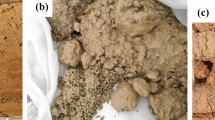Abstract
To prevent the collapse and settlement of fine granular soil during earth pressure balance (EPB) tunneling or tunneling balance machine (TBM) operations, foaming agent mixing is one of the most efficient techniques. This work focuses on the stability of loose sandy-clay soil conditioned with the foaming agent. Four reconstituted loose sandy-clay soils were conditioned with the foaming agent CLB F5/AC. Using optical observation, Turbiscan analysis, and foam volume determination, the stability of foam mixed with fine soils was studied based on drainage coalescence and coarsening phenomena that occurred over time. Additionally, foam stability under gravity drainage was analyzed through a (one-dimensional) 1D column experiment. Variation in the FIR (foam injection ratio) shows that there is a limit FIR value from which the foam begins to be observed in the soil sample, involving a discontinuous porosity increase to the detriment of the continuous porosity decrease. An approach that considered this discontinuous porosity generated by the inclusion of gas bubbles was used to describe foam bubble degradation. Tests carried out on foam alone showed its rapid degradation compared with that of the foam added and mixed in the soil. Fine particles of clay allow foam stability even in the soil mixture. The foam volume in the soil decreases according to constant volume stages separated by a fast volume decrease. Both drainage and coalescence phenomena have occurred significantly for high values of FIRs. From the 1D column experience, foam bubbles modify the drainage kinetics by accelerating the drainage velocity compared with that of unconditioned soil. The foam behavior evolution over time when mixed with the soil can be analyzed using the same theory of the behavior of the foam alone.















Similar content being viewed by others
References
AFNOR NF P 94-093 , (1999). « Sols : Reconnaissance et essaisDétermination des référencesde compactage d'un matériau. Essai Proctor normal-Essai Proctor modifié », Édited by Association Française de Normalisation (AFNOR).
Arriaga, L. R., Drenckhan, W., Salonen, A., Rodrigues, J. A., Iniguez-Palomares, R., Rio, E., & Langevin, D. (2012). On the long-term stability of foams stabilised by mixtures of nano-particles and oppositely charged short chain surfactants. Soft Matter, 8(43), 11085–11097. https://doi.org/10.1039/C2SM26461G.
Bezuijen, A., (2012). Foam used during EPB tunnelling in saturated sand, parameters determining foam consumption. In: Proceedings WTC 2012. Bangkok, pp. 267–269. DOI: https://doi.org/10.1201/b12748-19.
Bezuijen, A. Foam parameters in saturated sand, theory and model tests Underground - The Way to the Future: Proceedings of the World Tunnel Congress, WTC 2013; Geneva.
Borio, L., & Peila, D. (2010). Study of the permeability of foam conditioned soils with laboratory tests. American Journal of Environmental Science, 6(4), 365–370. https://doi.org/10.3844/ajessp.2010.365.370.
BS EN 12350–2 , (2009). Testing fresh concrete – Part 2: Slump-test.
Budach, C., & Thewes, M. (2015). Application ranges of EPB shields in coarse ground based on laboratory research. Tunnelling and Underground Space Technology, 50, 296–304. https://doi.org/10.1016/j.tust.2015.08.006.
Destribats, M., Schmitt, V., and Backov, R. (2009). Thermostimulable Wax-SiO2 core-shell particles. Langmuir. Doi:https://doi.org/10.1021/la902828q.
Djeran-maigre I., Dubujet, P., Limaiem, M., Selmi, M., Mesticou, Z, Euzen, G., Acherie, S. and Kacem, M. (2016). Comportement des sols excaves par tunnelier a pression de terre et traites par additifs. Journées Nationales de Géotechnique et de Géologie de l’Ingénieur – Nancy, 2016.
Drenckhan, W., & Langevin, D. (2010). Monodisperse foams in one to three dimensions. Current Opinion in Colloid & Interface Science, 15(5), 341–358. https://doi.org/10.1016/j.cocis.2010.06.002.
Fameau, A.-L., & Salonen, A. (2014). Effect of particles and aggregated structures on the foam stability and aging. Comptes Rendus Physique, 15(8–9), 748–760. https://doi.org/10.1016/j.crhy.2014.09.009.
Gibbs J. W.(1906). The scientific papers of J. Willard Gibbs (Vol.1). Longmans, Green and Company, Oxbow press, Woodridge.
Hajialilue-Bonab, M., Sabetamal, H., & Bezuijen, A. (2014). Experimental study on foamed sandy soil for EPB tunnelling. Advances in Railway Engineering, An International Journal, 2(1), 27–40.
Hilgenfeldt, S. Koehler, S.A. and Stone, H.A.(2001). “Dynamics of coarsening foams : accelerated and self-limiting drainage.” Physic Review letters, Vol. 86, No. 20, pp. 4704. Doi: https://doi.org/10.1103/PhysRevLett.86.4704.
Höhler, R., & Cohen-Addad, S. (2005). Rheology of liquid foam. Journal of Physics: Condensed Matter, 17(41), R1041.
Jancsecz, S., Krause, R., & Langmaack, L. (1999). Advantages of soil conditioning in shield tunnelling: experiences of LRTS Izmir. Challenges for the 21st Century. Alten et al (eds), 865–875.
Langevin, D. Rio, E. (2006). Coalescence in foams and emulsions. in: P. Somasundaran (Ed.), Encyclopedia of Surface and Colloid Science, second edition, Taylor and Francis, New York, pp. 1–15.
Langmaack, L., (2009). The truth about soil conditioning: dos and don’ts. In: Proceedings World Tunneling Conference, Budapest, Hungary, May 23–28.
Langmaack, L., & Lee, K. F. (2016). Difficult ground conditions? Use the right chemicals! Chances–limits–requirements. Tunnelling and Underground Space Technology, 57, 112–121.
Lioumbas, J., Georgiou, S., Kostoglou, E. M., & Karapantsios, T. D. (2015). Foam free drainage and bubbles size for surfactant concentrations below the CMC. Colloids and Surfaces A: Physicochemical and Engineering Aspects, 487, 92–103. https://doi.org/10.1016/j.colsurfa.2015.09.050.
Mengual, O., Meunier, G., Cayré, I., Puech, K., & Snabre, P. (1999). TURBISCAN MA 2000: Multiple light scattering measurement for concentrated emulsion and suspension instability analysis. Talanta, 50(2), 445–456.
Milligan, G., (2000). “Lubrication and soil conditioning in tunneling, pipe jacking and microtunneling, a state of the art review.” Geotechnical Consulting Group, G.W.E, Milligan.
Peila, D., Oggeri, C., & Borio, L. (2009). Using the slump test to assess the behavior of conditioned soil for EPB tunneling. Environmental & Engineering Geoscience, 15(3), 167–174. https://doi.org/10.2113/gseegeosci.15.3.167.
Pedraza A., Selmi M., Mesticou Z., Dubujet Ph., Kacem M. and Murillo C, (2015). Temporal analysis of side effects produced by foam agents in the soil excavated with Earth Pressure Balance (EPB). From Fundamentals to Applications. in Geotechnics: Proceedings of the 15th Pan-American Conference on Soil Mechanics and Geotechnical Engineering, Buenos Aires, Argentina, D. Manzanal and A.O. Sfriso (Eds.) IOS Press,712–721. DOI: 10.3233/978-1-61499-603-3-712
Psomas, S, (2001). Properties of foam/sand mixtures for tunnelling applications. Master’s thesis, M.S. thesis, Univ. of Oxford, Oxford, U.K.
Puzrin, A. M., Tront, J., Schmid, A., & Hughes, J. B. (2011). Engineered use of microbial gas production to decrease primary consolidation settlement in clayey soils. Geotechnique, 61(9), 785–794. https://doi.org/10.1680/geot.9.T.023.
Oggeri C., Fenoglio T.M. and Vinai R. (2014). Tunnel spoil classification and applicability of lime addition in weak formations for muck reuse. TUST Tunnelling and underground space technology, n.44, 97-107. Doi: https://doi.org/10.1016/j.tust.2014.07.013.
Özarmut, A. Ö., & Steeb, H. (2015). “Rheological properties of liquid and particle stabilized foam”. In Journal of Physics: Conference Series (Vol. 602, No. 1, p. 012031). IOP Publishing.
Quebaud, S., Sibai, M., & Henry, J. P. (1998). Use of chemical foam for improvements in drilling by earth-pressure balanced shields in granular soils. Tunnel. Underground Space Technol., 13(2), 173–180. https://doi.org/10.1016/S0886-7798(98)00045-5.
Saint-Jalmes, A. (2006). Physical chemistry in foam drainage and coarsening. Soft Matter, 2, 836–849. https://doi.org/10.1039/B606780H.
Saulnier, L. (2012). Étude de la coalescence et du mûrissement dans les mousses liquides :des expériences modèles à différentes échelles. PhD thesis, Paris Sud.
Saulnier, L., Drenckhan, W., Larré, P. E., Anglade, C., Langevin, D., Janiaud, E., & Rio, E. (2015). In situ measurement of the permeability of foam films using quasi-two-dimensional foams. Colloids and Surfaces A: Physicochemical and Engineering Aspects, 473, 32–39. https://doi.org/10.1016/j.colsurfa.2015.01.009.
SCCEPG, (2005). Self-Compacting Concrete European Project Group. The European guidelines for self-compacting concrete: Specification, production and use. International Bureau for Precast Concrete (BIBM) 63p.
Schramm, L. L., & Wassmuth, F. (1994). Foams: Fundamentals and applications in the petroleum industry. American Chemical Society, 242, 3–45. https://doi.org/10.1021/ba-1994-0242.fw001.
Selmi, M., Kacem, M., Jamei, M., Dubujet, Ph. (2016). “Effects of foaming agent on hydro-mechanical properties of soil excavated by earth pressure balance (EPB).” World Academy of Science, Engineering and Technology, International Journal of Environmental, Chemical, Ecological, Geological and Geophysical Engineering, Vol. 3, N°7, 758–762, 2016.
Fu, T., Ma, Y., & Li, H. Z. (2015). Bubble coalescence in non-Newtonian fluids in a microfluidic expansion device. Chemical Engineering and Processing: Process Intensification, 97, 38–44. https://doi.org/10.1016/j.cep.2015.08.008.
Tao, L., Chen, Z., Cui, J., Wang, H., & Fang, Y. (2019). Experimental methods to assess the effectiveness of soil conditioning with foam in fully weathered granite. Advances in Materials Science and Engineering, 12. https://doi.org/10.1155/2019/9046704.
Thewes, M., & Budach, C. (2010). Soil conditioning with foam during EPB tunnelling. Geomechanics and Tunnelling, 3(3), 256–267. https://doi.org/10.1002/geot.201000023.
Thewes, M., Budach, C., and Bezuijen, A., (2012). Foam conditioning in EPB tunneling. In: Viggiani (Ed.), Geotechnical aspects of underground construction in soft ground. Taylor & Francis Group, London.
Varade, D., Carriere, D., Arriaga, L. R., Fameau, A. L., Rio, E., Langevin, D., & Drenckhan, W. (2011). On the origin of the stability of foams made from catanionic surfactant mixtures. Soft Matter, 7(14), 6557–6570. https://doi.org/10.1039/C1SM05374D.
Vinai, R., Oggeri, C., & Peila, D. (2008). Soil conditioning of sand for EPB application: A laboratory research. Tunneling and underground Space Technology, 23, 308–317. https://doi.org/10.1016/j.tust.2007.04.010.
Wheeler, S. J. (1988). A conceptual model for soils containing large gas bubbles. Geotechnique, 38(3), 389–397.
Wu, Y., Mooney, M. A., & Cha, M. (2018). An experimental examination of foam stability under pressure for EPB TBM tunneling. Tunneling and underground Space Technology, 77, 80–93. https://doi.org/10.1016/j.tust.2018.02.011.
Ying, G. (2006). Fate, behavior and effects of surfactants and their degradation products in the environment. Environment International, 32, 417–431. https://doi.org/10.1016/j.envint.2005.07.004.
Acknowledgments
The authors are grateful to CONDAT Company which provided the surfactant CLB F5™/AC.
Funding
This work was financially supported by the “PHC Utique” program of the French Ministry of Foreign Affairs and Ministry of higher education and research and the Tunisian Ministry of Higher Education and Scientific Research in the CMCU project number 15G1116 and mobility and work carried out with the financial support of the Rhône-Alpes Region.
Author information
Authors and Affiliations
Corresponding author
Additional information
Publisher’s Note
Springer Nature remains neutral with regard to jurisdictional claims in published maps and institutional affiliations.
Rights and permissions
About this article
Cite this article
Selmi, M., Kacem, M., Jamei, M. et al. Physical Foam Stability of Loose Sandy-Clay: a Porosity Role in the Conditioned Soil. Water Air Soil Pollut 231, 251 (2020). https://doi.org/10.1007/s11270-020-04598-8
Received:
Accepted:
Published:
DOI: https://doi.org/10.1007/s11270-020-04598-8




